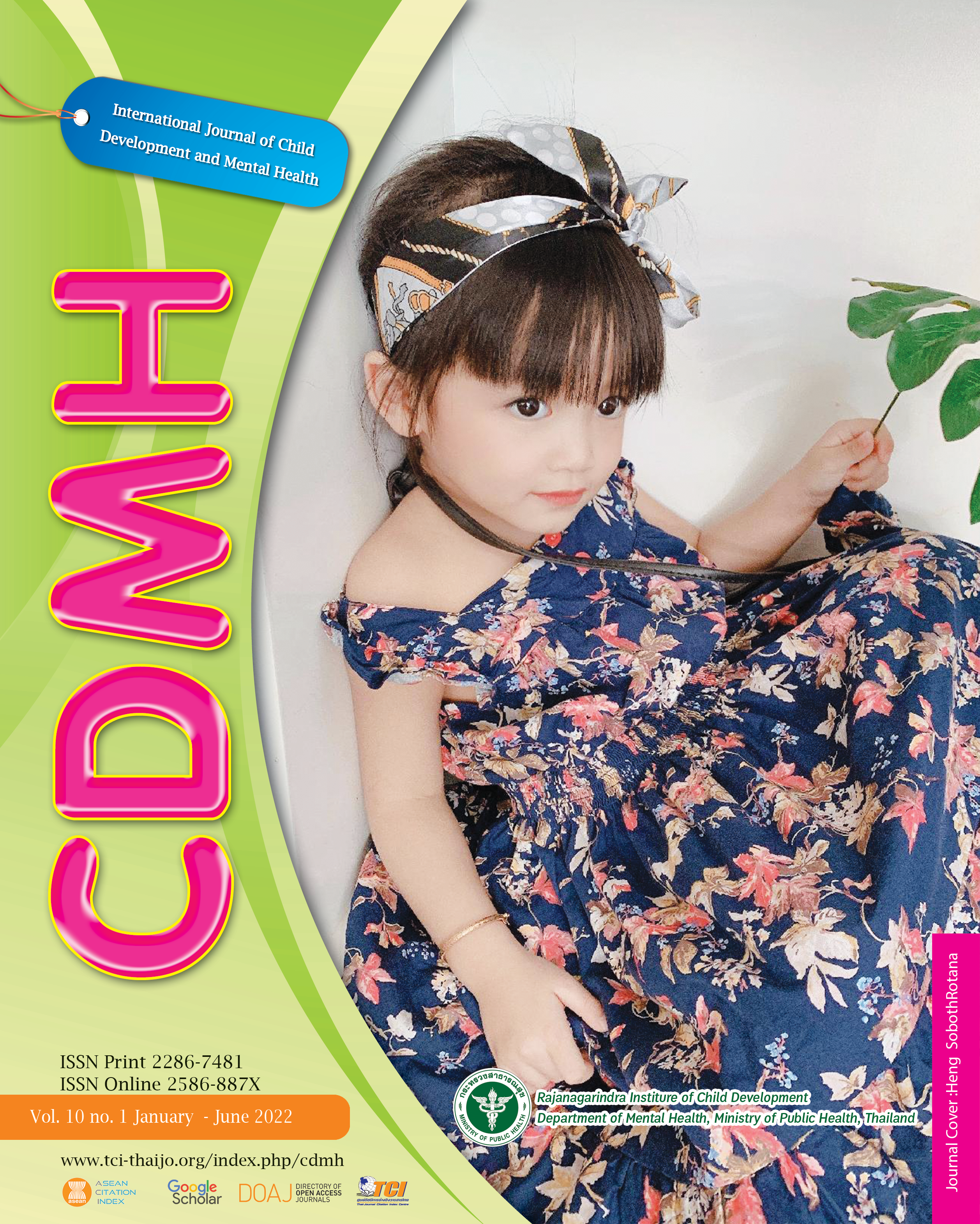Case study of the results of Applied Behavioral Analysis: Incidental Teaching by parents to speech and language performance of Autistic child age 2:4 year Incidental teaching and speech/ language development in ASD
Main Article Content
Abstract
Incidental teaching ( IT) is a strategy that uses the principles of Applied Behavior Analysis (ABA) to provide structured learning opportunities in the natural environment using the child’s interests and natural motivation. This technique had five steps 1.Watching for the child to initiate (watch) 2.Remove the desire object (remove), 3.Ask for request (ask),4.Pause for 10-30 second, 5.Give the reword (object in steps 2).Report outcomes presented that parent -child interaction with implement IT technique over 6 month period significantly improved the speech and language skills of children with ASD aged 2:4 years. The child able to produce almost all Thai phonetic sounds except / ph/ and/ th/ and had MLU increasing from unable to calculated into 1.89 at the end of the study. This preliminary study, suggest further investigation, including a standard research study would yield valuable clinical findings.
Article Details

This work is licensed under a Creative Commons Attribution-NonCommercial-NoDerivatives 4.0 International License.
![]()
Creative Commons License
This work is licensed under a Creative Commons Attribution-NonCommercial-No Derivatives 4.0 International (CC BY-NC-ND 4.0)
The authors retain copyright and permit the journal the copyright of first publication
Articles, once having passed the review process and accepted for publication in the CDMH Journal, are copyrighted under the CDMH Journal, Department of Mental Health, Ministry of Public Health. Please be aware distribution of CDMH Journal content for commercial purposes without permission is expressly prohibited. However, distribution with intent to educate, advocate, or spread awareness within the general public and research communities is permitted and encouraged with the understanding that the CDMH Journal Editorial Board do not hold jurisdiction or liability for any accompanying comments, text, or information from third parties, either in favor for or against the original article’s assertions, conclusions, methodology, or content.
References
Fenske E. C, Krantz P. J, McClannahan L. E. Incidental teaching: A not-discrete-trial teaching
procedure. In: Maurice C, Green G, Foxx R. M, (2001) Making a Difference: Behavioral
intervention for autism. Austin, TX: PROED. pp. 75–82.
Hart, b., & risley, t. R. (1974). Using preschool materials to modify the language of
disadvantaged children 1. Journal of applied behavior analysis, 7(2), 243-256.
Hart, B., & Risley, T. R. (1975). Incidental teaching of language in the preschool 1. Journal of
applied behavior analysis, 8(4), 411-420.
Hart, B., & Risley, T. R. (1982). How to use incidental teaching for elaborating
language. Lawrence, KS: H & H Enterprises.
Hart, B., & Risley, T. R. (1995). Meaningful differences in the everyday experience of young
American children. Baltimore, Paul H Brookes Publishing.
Hsieh, H. H., Wilder, D. A., & Abellon, O. E. (2011). The effects of training on caregiver
implementation of incidental teaching. Journal of Applied Behavior Analysis, 44(1), 199-
Lovaas, O. I. (1987). Behavioral treatment and normal educational and intellectual functioning
in young autistic children. Journal of consulting and clinical psychology, 55(1), 3.
McGee, G. G., Krantz, P. J., Mason, D., & McClannahan, L. E. (1983). A modified incidental‐
teaching procedure for autistic youth: Acquisition and generalization of receptive object
labels. Journal of Applied Behavior Analysis, 16(3), 329-338.
McGee, G. G., Morrier, M. J., & Daly, T. (1999). An incidental teaching approach to early
intervention for toddlers with autism. Journal of the association for persons with severe
handicaps, 24(3), 133-146.
McGee, G. G., & Daly, T. (2007). Incidental teaching of age-appropriate social phrases to
children with autism. Research and Practice for Persons with Severe Disabilities, 32(2),
-123.
Miranda-Linné, F., & Melin, L. (1992). Acquisition, generalization, and spontaneous use of
color adjectives: A comparison of incidental teaching and traditional discrete-trial
Ryan, C. S. (2011). Applied behavior analysis: Teaching procedures and staff training for
children with autism. Autism Spectrum Disorders-From Genes to Environment, 191-212.
Schepis, M. M., Reid, D. H., Fitzgerald, J. R., Faw, G. D., Pol, R. A. V. D., & Welty, P. A.
(1982). A program for increasing manual signing by autistic and profoundly retarded
youth within the daily environment. Journal of Applied Behavior Analysis, 15(3), 363-
Wilczynski, S. M., Cowan, R. J., Wolf, K., Vause, T., Lewis, L. J., & Hayes, A. (2003). Project
BEST-CASE: A model for structuring an intensive early childhood intervention program
for children with autistic spectrum disorder. Proven Practice: Prevention & Remediation
Solutions for Schools, 5, 23-36.


